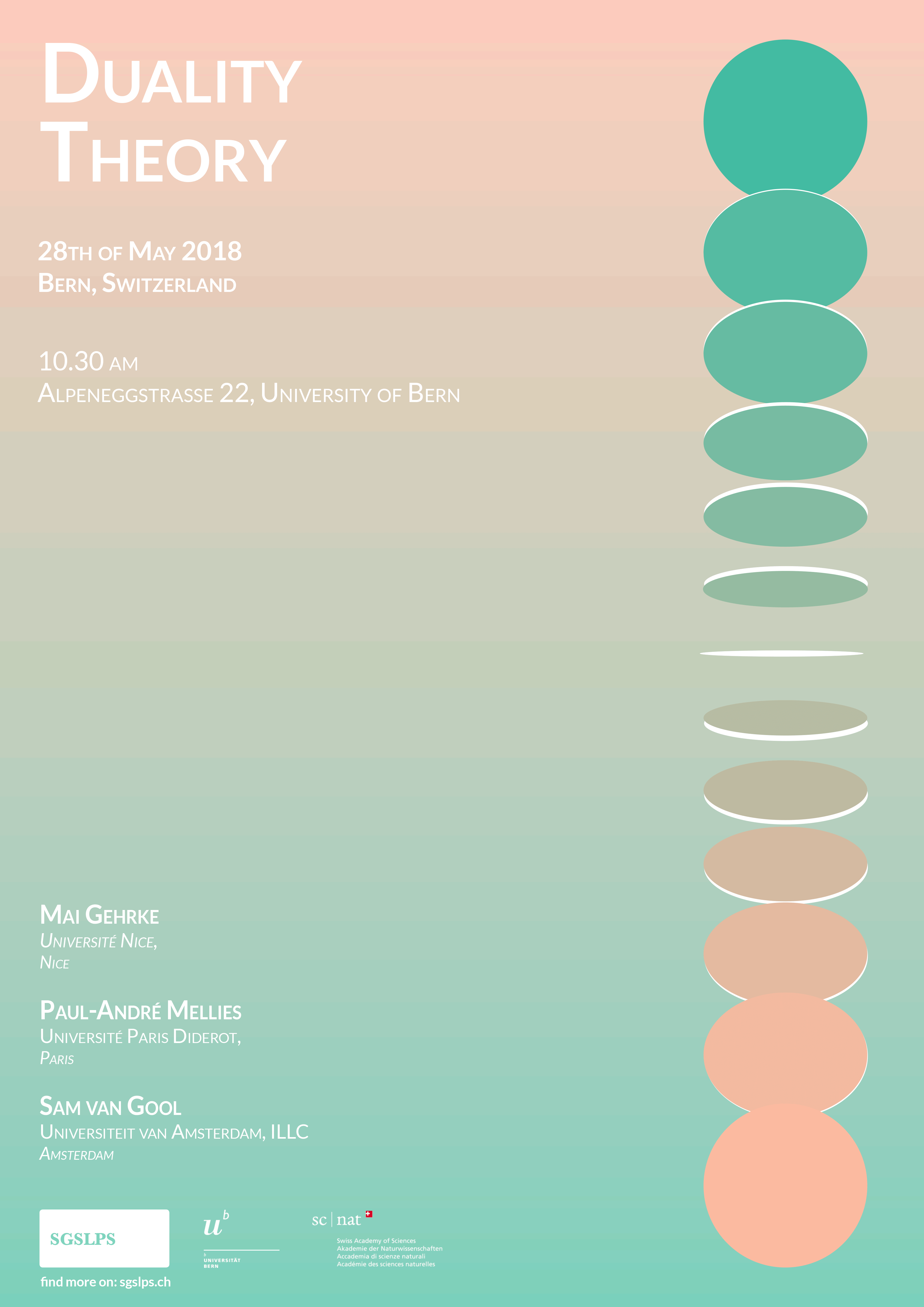
Duality Theory
In 1936, Marshall Stone discovered a representation for all Boolean algebras, obtained by using topological spaces, which gave algebraists a usable understanding of their structure. During the same years, two similar results were proved, by Garrett Birkhoff and by Lev Pontryagin, respectively for the class of finite distributive lattices and for the class of abelian groups. These three results planted the seeds for what is nowadays called Duality Theory. The beauty and the strength of this theory relies on the fact that it translates algebraic problems into dual topological problems, and this results in the possibility of making use of our geometric intuitions to study and tackle problems stated in abstract symbolic language.
Abstracts and Slides
Duality for distributive lattices with additional operations: a tutorial in two parts
Mai Gehrke and Sam van Gool
The mathematical theory of Stone duality underlies a deep connection
between syntax and semantics in logic and theoretical computer science,
and allows for powerful applications in both of these research fields.
In particular, duality for distributive lattices provides a canonical
notion of ‘model’ for any logical system with a distributing conjunction
and disjunction. Duality theory for additional operations then helps
to understand how the different connectives of the logic are reflected
in these models. As an important classical example, Kripke semantics
for intuitionistic and modal logics can be understood in this way.
More recently, in joint work with V. Marra, we apply these ideas to
multi-valued Lukaciewicz logic.
In this two-part tutorial, we will introduce duality for distributive
lattices and additional operations from scratch, starting from the
simple case of finite distributive lattices, and ending with full
Priestley duality for expansions of distributive lattices.
Along the way, we will illustrate the theory by showing applications
to some of the logics mentioned above.
Sheaf representations and duality
Mai Gehrke
A sheaf of algebras is a structure half-way between algebra and
topology. It allows the dualization of part of the structure of
an algebra, while the remainder of the structure, residing in
the `stalks’ of the sheaf, remains algebraic. This allows one
to represent algebras as `continuously varying’ versions of
simpler algebras: e.g. commutative rings with identity may be
een as continuously varying `local rings’ and MV-algebras
(the algebraic counterpart of Łukasiewicz infinitary propositional
logic) may be seen as continuously varying MV-chains. It has long
been known in universal algebra that any distributive sublattice
of pairwise permuting congruences of an algebra yields a sheaf
representation of the algebra. In joint work with Sam van
Gool [1], we provide a generalization of this fact and prove a
converse of the generalization. A central contribution of our
work has been to identify stably compact spaces and the notion
of softness for sheaves as central ingredients in getting a
bijective correspondence. Stably compact spaces were first
identified by Nachbin and are closely related to compact
partially ordered spaces. They provide a non-Hausdorff
counterpart to compact Hausdorff spaces. The notion of
softness of sheaves originated with Godement’s treatment of
homological algebra. In the special case where the algebras we
want to represent have a distributive lattice reduct, we obtain
a fully dualized description of sheaf representations over stably
compact spaces as certain continuous bundles.
Our work grew out of our work on sheaf representations of
MV-algebras with Marra [2] and as such it is closely related to
recent work on sheaf representations for MV-algebras and ℓ-groups.
[1] M. Gehrke, S. J. v. Gool, Sheaves and duality. Journal of
Pure and Applied Algebra 222 (2018) 2164–2180.
[2] M. Gehrke, S. J. v. Gool, V. Marra, Sheaf representations
of MV-algebras and lattice-ordered abelian groups
via duality. Journal of Algebra 417 (2014) 290–332.
Type Refinement Systems and Duality
Paul-André Melliès
In this introductory and survey talk, I will review a number of
elements of my ongoing work with Noam Zeilberger on type
refinement systems and duality. I will start by explaining the
meaning of the Isbell duality between the categories [C,Set]
and [C^op,Set] of covariant and contravariant presheaves on a
small category C. This duality will be then extended to the
more general setting of type refinement systems [1]. The relevance
of the construction will be illustrated by a number of fundamental
and subtle issues in proof theory and substructural logics.
If time permits, this trail will eventually lead us to the
bifibrational reconstruction of Lawvere's presheaf hyperdoctrine
in [2], following the philosophy of chiralities initiated and
advocated in [3].
[1] Paul-André Melliès and Noam Zeilberger.
An Isbell Duality Theorem for Type Refinement Systems.
Math. Struct. in Comp. Science (2018), vol. 28, pp. 736-774.
[2] Paul-André Melliès and Noam Zeilberger.
A bifibrational reconstruction of Lawvere's presheaf hyperdoctrine.
Proceedings of LICS 2016: 555-564
[3] Paul-André Melliès.
Dialogue Categories and Chiralities
Publications of the Research Institute for Mathematical Sciences, Volume 52, Issue 4, 2016, pp. 359–412.